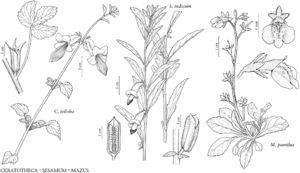Ceratotheca triloba
Bot. Mag. 114: plate 6974. 1888.
Stems branched proximally, slightly 4-angled, 50–150 cm. Leaves: petiole 2–10(–15) cm, hairy; blade broadly ovate to cordate or triangular, 3–10(–20) × 3–10 cm, base rounded to cordate, apex obtuse to acute. Inflorescences secund. Pedicels 2–4 mm; bracteoles 0–2, linear. Flowers drooping; sepals often purple distally, 7–10 mm; corolla 25–40 mm, glandular-pubescent externally, strongly curved at base, mouth 15 mm diam. Capsules 20–30 × 4–5 mm. Seeds 2–4 mm, smooth. 2n = 32 (Africa).
Phenology: Flowering Jul–Nov.
Habitat: Disturbed sites.
Elevation: 0–100 m.
Distribution
Introduced; Fla., s South Africa (Natal).
Discussion
Plants of Ceratotheca triloba resemble those of Digitalis with their tall, herbaceous habit, secund racemes curved toward the tip, and drooping, tubular flowers. Capsules of C. triloba are four-locular and have two subapical, hornlike appendages, basal leaves sometimes three-foliolate, and corolla lobes relatively large and rounded. Plants escaped from cultivation are known from Highlands and Lake counties.
Another species, Ceratotheca sesamoides Endlicher, distinguished by smaller flowers, dense indument, and all leaves simple, is sometimes cultivated in the flora area.
Selected References
None.
